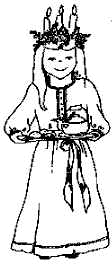
Vasa Order of America
A Swedish American Fraternal Organization
Lucia Day -- Festival of Lights and Harbinger of Christmas in Scandinavia
For over 1,000 years, Christians in Scandinavia have celebrated Saint Lucy, symbolizing both the enduring spiritual light of faith and the return of the sun's physical light. The current Lucia day tradition began over 100 years ago in Sweden’s wealthier farming districts and has spread through much of Scandinavia. Originally, one young maiden in each village, wearing white gown with red sash and carrying a torch, would venture out into the cold night to bring food and drink to all the surrounding households, returning home by daybreak. This custom honors the numerous visions of Saint Lucy, head aglow with candles, as she accompanied the mysterious arrival of grain and food in famine-wracked villages, just when all appeared lost. 
As the 20th century progressed, Scandinavians began to reenact the Lucia tradition in their homes, as many still do today. In the early hours of December 13th, the eldest daughter, dressed in white gown, red sash and a crown of lingonberry branches topped with seven glowing candles, wakes the household singing the Italian refrains of the traditional Lucia song. She is accompanied by her brothers, dressed as "star boys"' with long white gowns and white cone-shaped hats adorned with golden stars, or “baker boys” with baker hats. The Lucia maiden carries a tray of steaming coffee and the traditional pastry, called Lussekattor, or "Lucy Cats". These saffron buns, studded with raisins, are baked in symbolic shapes, including a cross, a crown, and the letter "S" to represent the eyes of Saint Lucia.
In recent years, the Lucia tradition has become more of a public celebration, with festivities extending well beyond the home. There are processions and contests in almost every school and town. There are processions in hospitals, offices, factories -- -- even on SAS flights! It is not unusual for hotel guests to be awakened on Lucia Day by a white-robed girl bearing a tray of coffee and pastry. The holiday celebration carries on everywhere into the day and evening. The Lucia Festival is indeed one of the most fondly cherished holiday rituals in Sweden.
The celebration of Santa Lucia in Scandinavia has ancient roots in distant places. According to apocryphal writings, the original Lucia was a beautiful, well-born maiden in Sicily during the early days of Christian persecution under the Roman Emperor Diocletian. A Christian convert, Lucia is said to have carried food to fellow Christians who hid from persecutors in the dark catacombs, lighting her way with a crown of candles. In 304 AD, she was martyred for her belief on the day of the winter solstice, December 13th according to the Julian calendar then in use. Her body was taken to Constantinople and later Venice, where her bones reside at the Church of Santa Lucia.
Death, however, proved to be a catalyst for her fame. Lucia is mentioned in Roman writings and in an inscription at Syracuse dating from 400 AD, less than one hundred years after her death. Far from fading with time, her veneration among Christians grew and spread abroad: two churches founded before the 8th century in Britain are known to have been dedicated to Saint Lucy at a time when the populace there was more pagan than Christian. Some historians hypothesize that Viking invaders may have brought back the Lucia custom to Sweden where it took hold.
The Lucia celebration symbolizes the return of light and hope. One of the earliest Christian saints, she is said to have appeared in visions at times of the most dire need. Such visions are recorded in various locales, including Scandinavia. At the height of a terrible famine in Sweden, for instance, Saint Lucy was seen at the helm of a ship loaded with grain as it crossed Lake Vannern to bring relief to the starving villagers. To this day, some Scandinavians believe that midnight on December 13th is a time when miracles happen.
For Scandinavian Christians, Lucia symbolizes hope and light in the coming birth of Christ, the Light of the World. The name Lucy actually means "light" and she is sometimes referred to as the Queen of Light. Lucia candles are lit in homes, harkening back to older times when large Lucia fires were held out of doors. The Lucia maiden’s lighted crown and even the yellow saffron buns, are also symbols of light. She inevitably became associated with the eyes, the "light" of the body. Lucia Day was also intertwined with the far older light-and-fire Yuletide customs from the pre-Christian era. In addition to its religious associations, the festival represents the returning of the sun as days begin to get longer. The renewed sense of faith, hope and growth that the Lucia festival brings is welcome indeed in a land where daylight hours are scarce at this time of the year!
Credits: Research by Dalarna-Blaklockan Children’s club (NJ)